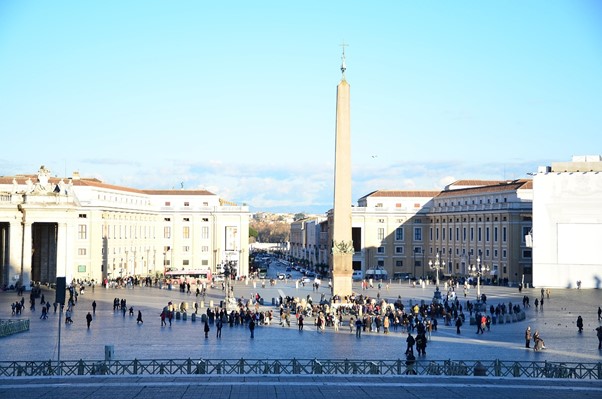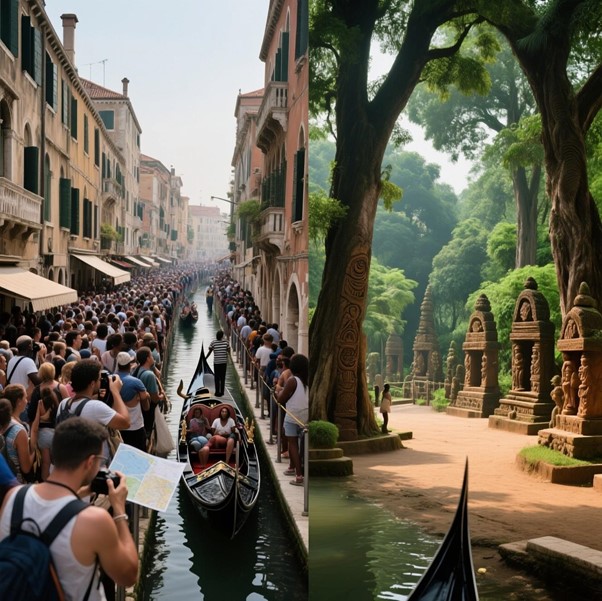Countries across the world are weeping because of the dilapidating effect of overtourism. Hearts of countries like Paris, Venice, and Barcelona are breaking under the force of “too many human beings” in their vicinity. These countries struggling with overtourism have their sites and infrastructure damaged.
For example, despite having only 882 residents, Vatican City welcomes over 6.8 million tourists each year, many of whom are attracted by attractions like the Sistine Chapel and St. Peter’s Basilica. The outcome? Long lines, packed squares, and everyday life overtaken by the influx of tourists. Not less than the number of fingers on a palm this year, the Conclave and Pope Francis’ death caused tens of thousands of tourists to flock to Rome and Vatican City.
Likewise, a mountain state with fewer than 82,000 inhabitants, Andorra, receives 9.6 million tourists a year who come for duty-free shopping and skiing. Its alpine tranquillity is becoming more and more scarce, as every street is burdened with tourists. Also, situated on a ridge, San Marino’s mediaeval atmosphere belies its popularity, with only 33,581 residents and roughly 2 million tourists annually. You can feel the mob waiting to arrive even when you’re strolling down its cobblestone streets at off-peak hours. Moreover, over 11 million tourists visit the island nation of the Bahamas each year, particularly during celebrations like Carnival or spring break — a destination with just 401,000 inhabitants. Although the beaches are still glistening, the local life and infrastructure seem to be getting overwhelmed. The islands of Saint Kitts and Nevis are not left out. It receives more than 875,000 visitors yearly when it’s only home to 46,843 residents.

In juxtaposition, Africa’s most populous country possesses tourism infrastructure that crumbles as a result of neglect and its desire for relationships with humans — tourists that can love that storytelling place and visit it often. With over 227 million people, Nigeria’s diverse culture, historical monuments, fauna, mountains, beaches, and UNESCO-designated heritage sites are all part of its unique geographic environment. However, compared to South Africa’s 10 million or Egypt’s 13 million, the country only receives roughly 1.5 million tourists a year, and it only makes up less than 4% of Nigeria’s GDP. The giant of Africa has been unable to carve out a place for itself in the global tourism market, which is why the country continues to get relatively few tourists each year. In essence, as other countries struggle to keep tourists out, Nigeria struggles to bring them in.
Why Nigeria Struggles
Travel agent and tour operator, Cordis-Maria Umeokoli said that Nigeria struggles to add up to the country’s annual GDP even though it is blessed with numerous attractions and products worthy of being showcased at the international markets.
“Most people are not even aware of all the tourism products we have in Nigeria. You can imagine an eleven-year-old kid who doesn’t even know there’s a waterfall in Nigeria, or even a grown-up adult who thinks that you can only find beaches in Lagos State. That narrows it down to awareness and advertising. Nigeria needs to advertise what she has to the international market.”
Umeokoli stated that Nigerians are suffering the imported kind of inflation where everything and everybody depends on dollars because of international trade and imports. “When inbound tourism is way higher than outbound tourism, the dollar and other forex will be more available in the country. Also, the promotion of inbound tourism will reduce the demand for dollars and PTA drastically, thereby increasing the value for the naira.”

The tour operator said that poor management, lack of interest by the government and many more are the problems associated with dilapidated sites. “There’s also the problem of security, which is a major one.”
Another tourism expert and promoter, Prisca Ekenimoh, said that currently, international tourism in Nigeria has declined staggeringly due to the country’s lack of focus and lackadaisical attitude.
According to Ekenimoh, “People no longer explore tourism attractions as before, and the government has not done so much in the tourism sector. There are so many beautiful tourist attractions waiting to be explored. Rather than depending solely on the oil and gas sector, the government should tap into the tourist sector. The revenue generated from tourists all over the world who come to visit the country would be used to enhance the economy, just like African countries such as Egypt, Kenya, Tanzania and even Ghana.”
The passionate tourism promoter said that the most important role the government has to play in ensuring an enabling society for tourism to thrive is by improving the security of the country. “There should be more information on Nigerian tourism through the use of social media and promotion of tourist attractions.”
Understanding Undertourism
This phenomenon Nigeria faces, is called under tourism, which refers to places that are worth visiting and culturally diverse yet receive less tourists than other places of a similar nature. Limited marketing, antiquated beliefs, or inadequately developed tourism infrastructure could be the cause of this. Nations such as Albania, Moldova, and Laos experience this despite their stunning architecture, fascinating histories, and thriving culinary scenes. However, they aren’t on the travel list of most people and much publicised on the gram and these places only get a percentage of the tourists they could.
Like overtourism, undertourism can have negative effects. A destination loses out on economic opportunities when it receives fewer guests. Travelling is a gift that comes with responsibilities. Instead of aiming for the “perfect” places, tourists should prefer less-traveled areas—even if that means fewer English or less public transportation. In addition to bringing revenue and cultural exchange to communities that need more tourists while giving overcrowded hotspots a breather, it brings equilibrium when tourists are distributed. To meaningfully support under-visited communities, go beyond a day trip, select locally operated lodging, dine at neighborhood eateries, and spend the night there.


















